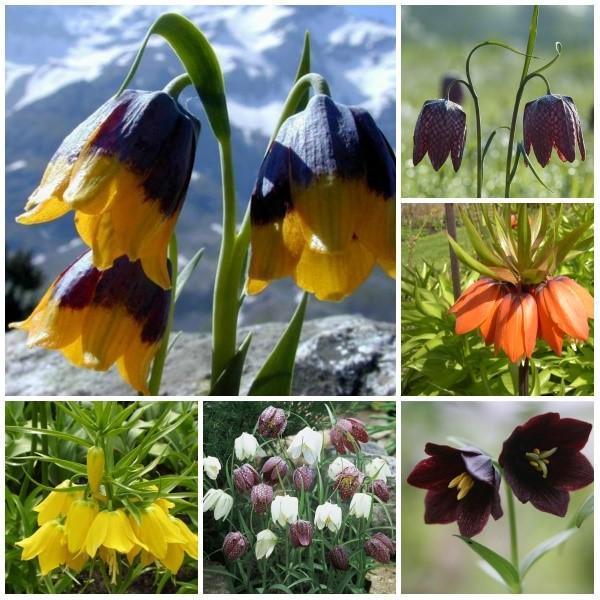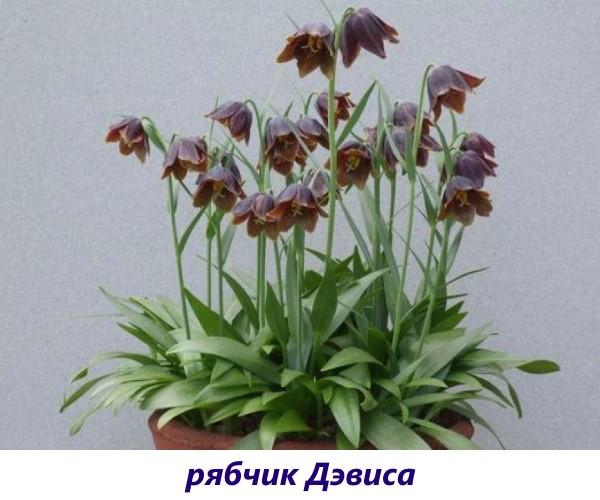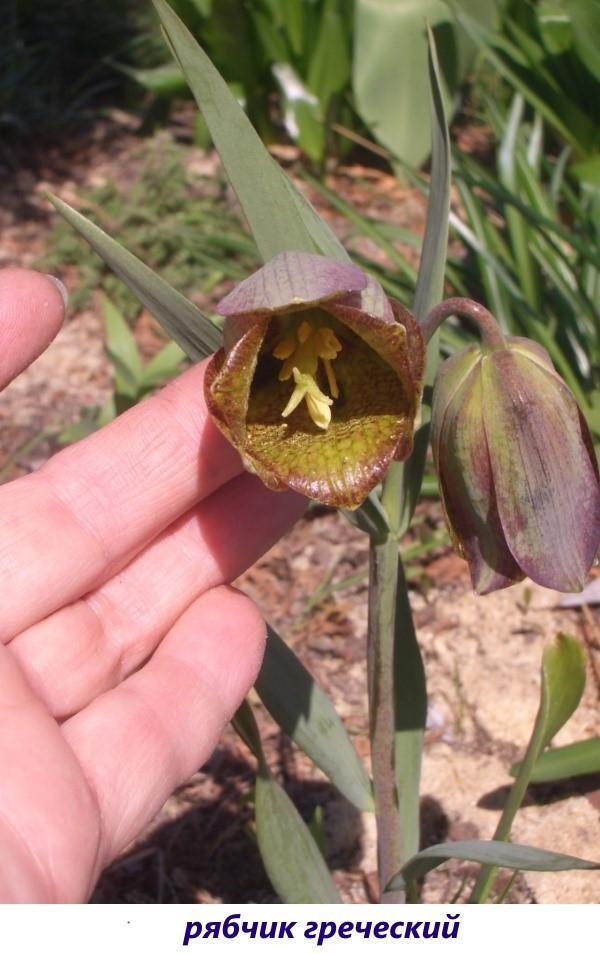Charming species of hazel grouse for a spring garden
 Among tulips and daffodils in early spring, one can often find hazel grouse flowersespecially in old courtyards. Lush bushes with a chic crown of orange or red paint are not the only species of hazel grouse. They can be called the classic version. However, true lovers of these flowers have other varieties. Original color, dark saturated colors, compact size - there is plenty to choose from. Today we want to bring to your attention an overview of the most beautiful hazel grouse. They will decorate flower beds in spring, when most of the plants are just starting to wake up.
Among tulips and daffodils in early spring, one can often find hazel grouse flowersespecially in old courtyards. Lush bushes with a chic crown of orange or red paint are not the only species of hazel grouse. They can be called the classic version. However, true lovers of these flowers have other varieties. Original color, dark saturated colors, compact size - there is plenty to choose from. Today we want to bring to your attention an overview of the most beautiful hazel grouse. They will decorate flower beds in spring, when most of the plants are just starting to wake up.
Types of hazel grouse: from modest handsome men to proud kings of a flower bed
Some of the most popular flowers that grow well and take root in flower beds are the following types of hazel grouse:
- Davis;
- golden;
- Persian;
- Mikhailovsky;
- Kamchatka;
- mountain;
- small;
- chess;
- imperial (yellow);
- pale-flowered.
Let's take a closer look at them.
Grouse Davis


Russian winters for hazel grouse Davis, in principle, are not very scary, if you adhere to certain recommendations:
- firstly, in the fall mulch bushes, creating additional protection from the cold - their foliage is sensitive to return frost;
- secondly, every two years, dig up the bulbs and bring them into the house for warming up.
Davis's hazel grouse is often confused with the Greek hazel grouse. Indeed, both plants are almost identical. However, the latter has a green stripe along the petals and is taller (up to 25 cm).
Hazel grouse
 Another undersized species, the height of its bushes does not exceed 15 cm. But the flowers of the hazel grouse are large, they make the stem bend over. This makes the flower look yellow. bell - petals of this color. Interestingly, an intricate pattern of a brownish-red hue is clearly visible on a yellow background. Sometimes it resembles simple dots, or it can cover the bud with a fine checkerboard mesh.
Another undersized species, the height of its bushes does not exceed 15 cm. But the flowers of the hazel grouse are large, they make the stem bend over. This makes the flower look yellow. bell - petals of this color. Interestingly, an intricate pattern of a brownish-red hue is clearly visible on a yellow background. Sometimes it resembles simple dots, or it can cover the bud with a fine checkerboard mesh.
Grouse is more resistant to low temperatures than, for example, Davis's hazel grouse. But in the northern regions, it is better to cover the bushes for the winter.
Hazel grouse
 Very beautiful and the only species of hazel grouse in its group called Theresia. It is a rather tall bush with a height of 60 to 130 cm. It forms one, but very strong and powerful inflorescence in the form of a cone. It is densely covered with small bells, of which there can be up to 50 pieces per plant. In the bud phase, they are greenish. When they begin to open, they turn black, with a dark purple tint. Bluish foliage only emphasizes the color depth of the inflorescence.Grouse blooms in late spring for several weeks.
Very beautiful and the only species of hazel grouse in its group called Theresia. It is a rather tall bush with a height of 60 to 130 cm. It forms one, but very strong and powerful inflorescence in the form of a cone. It is densely covered with small bells, of which there can be up to 50 pieces per plant. In the bud phase, they are greenish. When they begin to open, they turn black, with a dark purple tint. Bluish foliage only emphasizes the color depth of the inflorescence.Grouse blooms in late spring for several weeks.
Peach fritillaria (this is the scientific name of the species) can have a different color. So, in the Ivory Bell variety, the bells are pale green. New hybrids are generally two-colored: inside - cream, outside - brown.
When growing Persian hazel grouse, it is worth considering its southern character:
- when planting large bulbs deepen more, up to 30 cm;
- plant a flower, preferably on the south side of the site;
- the soil should be with drainage, and the place should be sunny;
- for the winter, the bushes are covered with fallen leaves;
- if the leaves began to turn yellow, in June the bulbs are dug up, heated and planted back after 3 weeks.
Persian hazel grouse reproduces by dividing or deep furrowing of the bulbs.
Grouse Mikhailovsky
 One of the brightest species with a two-tone color. Unusual bell flowers with bent petals bloom in early May. The inflorescences are large, dense, up to 8 cm in diameter. They are painted in a deep purple color, but the tips of the petals are yellow, with a slight green tint. It looks like someone dropped them in a paint can. The hazel grouse blooms for a long time - the flowers last up to three weeks. But already in the middle of summer, he hibernates.
One of the brightest species with a two-tone color. Unusual bell flowers with bent petals bloom in early May. The inflorescences are large, dense, up to 8 cm in diameter. They are painted in a deep purple color, but the tips of the petals are yellow, with a slight green tint. It looks like someone dropped them in a paint can. The hazel grouse blooms for a long time - the flowers last up to three weeks. But already in the middle of summer, he hibernates.
At the same time, the bushes themselves are low, with green narrow leaves, casting a bluish bloom. According to their height, they are divided into two groups:
- tall, up to 25 cm high, in which flowers are formed one by one on each peduncle;
- miniature, about 15 cm high, in which the flowers are slightly larger, but hang down in loose inflorescences of 2 or 3 pieces.
Mikhailovsky's bulbs are small, no more than 1.5 cm in diameter. They do not have a second pair of dense scales that would protect the juicy flesh. In this regard, the bulbs are often damaged during transplantation. The preferred breeding method is seed.
But pests feast on defenseless bulbs rarely - they do not smell very pleasant and taste pungent.
This species of hazel grouse is one of the most hardy and unpretentious. Neither the sun, nor the shadow, nor poor soil, nor drafts, nor frosts are afraid of him. Bushes tolerate wintering well without shelter, up to the central strip and even to the north. The hazel grouse is afraid of only one thing - dampness.
Hazel grouse
 One of the plant species that prefers moist, but light, soil. The height of the bush is on average 35 cm, but it can reach all 60 cm. The foliage is lanceolate, green, with a bluish tint familiar to hazel grouses. The root system is presented in the form of a bulb with serrated scales. The latter, in turn, are "built" of small onion scales. The bulbs are renewed every year and do not have last year's elements - the mother part dies by next spring.
One of the plant species that prefers moist, but light, soil. The height of the bush is on average 35 cm, but it can reach all 60 cm. The foliage is lanceolate, green, with a bluish tint familiar to hazel grouses. The root system is presented in the form of a bulb with serrated scales. The latter, in turn, are "built" of small onion scales. The bulbs are renewed every year and do not have last year's elements - the mother part dies by next spring.
In the photo of Kamchatka hazel grouse, you can see what a rich color it has. The flowers are composed of 6 petals. They are almost black, with a brown tint and a barely visible checkerboard pattern. The bush blooms in late May - early June.
Despite the beautiful coloration, the smell of flowers is not very pleasant, except for flies. But small onions have long been eaten. They are similar to rice grains, for which the hazel grouse is called "Indian rice".
There are several hybrids of Kamchatka hazel grouse, differing in structure and color from the parent species. In some varieties, brown pigment is in short supply, which is why the flowers are yellow-lemon. Other varieties have more luxurious inflorescences with a dozen or more petals.
Hazel grouse
 One of the species in which the chess pattern characteristic of hazel grouses is very clearly visible. A very delicate bush, loves the sun, but grows no more than 45 cm in height. He really has a fragile appearance: a thin stalk, narrow lanceolate leaves growing in pairs. Flowers are most often solitary, not large, but beautiful, bloom in late spring. Outside, the petals are claret-lilac, but on the inside, yellow predominates.
One of the species in which the chess pattern characteristic of hazel grouses is very clearly visible. A very delicate bush, loves the sun, but grows no more than 45 cm in height. He really has a fragile appearance: a thin stalk, narrow lanceolate leaves growing in pairs. Flowers are most often solitary, not large, but beautiful, bloom in late spring. Outside, the petals are claret-lilac, but on the inside, yellow predominates.
The mountain hazel grouse is considered an endangered species in most countries and is protected by law.In particular, in Ukraine it is listed in the Red Book.
This species is capable of producing seeds that can be harvested at the end of June. In addition, you can propagate a flower with the help of bulbs.
Hazel grouse
 Another variety with a characteristic spotted pattern. Most often found in damp meadows or along the edge of swamps. Photophilous, but not very picky about the soil. The bulb of the hazel grouse is small, while the height of the stem can reach 1 m. But the flowers themselves are medium-sized, rich burgundy. In the photo of the small hazel grouse, dull spots are visible, which are more distinct inside the flower. The upper surface of the petals is covered with a bluish bloom. They bloom at the end of April and bear fruit, which allows the hazel grouse to be propagated by seeds.
Another variety with a characteristic spotted pattern. Most often found in damp meadows or along the edge of swamps. Photophilous, but not very picky about the soil. The bulb of the hazel grouse is small, while the height of the stem can reach 1 m. But the flowers themselves are medium-sized, rich burgundy. In the photo of the small hazel grouse, dull spots are visible, which are more distinct inside the flower. The upper surface of the petals is covered with a bluish bloom. They bloom at the end of April and bear fruit, which allows the hazel grouse to be propagated by seeds.
The small hazel grouse is also found under the name chess-like. He also has a larger variety with fairly large white inflorescences. Unlike the first, she has not one flower, but whole inflorescences.
Hazel grouse
 The one who has really original flowers is the chess hazel grouse. It was for their color that it got its name. In a dark purple tone, a large cell is drawn with a pinkish sketch inside. Wild-growing hazel grouses bloom with single bell-buds. Domesticated varieties may have several of them. The bush itself is inconspicuous. It is short, with a stem no more than 35 cm in height, it has no more than 6 narrow leaves 10 cm long. And the diameter of the bulb is even less - only 1 cm. They prefer loose moist soil and partial shade - in the bright sun, the cell becomes paler.
The one who has really original flowers is the chess hazel grouse. It was for their color that it got its name. In a dark purple tone, a large cell is drawn with a pinkish sketch inside. Wild-growing hazel grouses bloom with single bell-buds. Domesticated varieties may have several of them. The bush itself is inconspicuous. It is short, with a stem no more than 35 cm in height, it has no more than 6 narrow leaves 10 cm long. And the diameter of the bulb is even less - only 1 cm. They prefer loose moist soil and partial shade - in the bright sun, the cell becomes paler.
Chess hazel grouse, growing in the wild and giving birth to many varieties, itself is gradually disappearing. In this regard, he is a "venerable member" of the Red Book.
Grouse imperial yellow
Among the variety of plant species, it is worth highlighting the imperial hazel grouse - one of the tallest flowers. It is he who can most often be found in flower beds. The hazel grouse looks really royal: a thick, but hollow stem rises above the neighboring flowers, growing up to 1.5 m in height. The bulbs are also of decent size - up to 10 cm in diameter. Along the entire length of the stem, there are green and shiny leaves, several pieces each. The inflorescence is formed closer to the apex, and a cap of smaller leaves covers it on top. Flowers, shaped like a bell, grow from the axils of the leaves in small groups, up to 7 pieces in each.
The most common color of this noble hazel grouse is orange. But the imperial yellow hazel grouse is no less beautiful. Its delicate bells beckon with a sunny color. There are among them both varieties with a rich yellow color, and paler tones.
So, such yellow hazel grouses are loved by flower growers:
- Imperial Lutea. The flowers are large, deep yellow in color with a green border near the nectarines.

- Raddeana. The most hardy variety with pale yellow, almost creamy bells.

- Striped Beauty. Inflorescences are dark yellow, even golden, with longitudinal reddish stripes along the petals.

Hazel grouse
 The pale-flowered hazel grouse will also delight you with yellow bells. True, his inflorescences are rather lemon-colored with a light green tint, but they are rather large and more rounded. The petals are almost even, in the sense that they do not turn outward. There are 10 to 12 flowers on the stem and their smell is not very pleasant, good, at least weak. The bush itself can be quite high - the stem is stretched 80 cm in height. The foliage, green with a gray tint, is wider and shorter than that of most of its relatives.
The pale-flowered hazel grouse will also delight you with yellow bells. True, his inflorescences are rather lemon-colored with a light green tint, but they are rather large and more rounded. The petals are almost even, in the sense that they do not turn outward. There are 10 to 12 flowers on the stem and their smell is not very pleasant, good, at least weak. The bush itself can be quite high - the stem is stretched 80 cm in height. The foliage, green with a gray tint, is wider and shorter than that of most of its relatives.
As you can see, the species of hazel grouse can surprise with their diversity. It is easy to grow this flower, it is not picky about care. Even if the bulbs are planted in a rarely visited dacha, hazel grouses will be able to live on their own. Choose the most interesting variety for yourself and diversify your front garden!